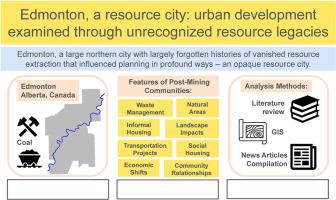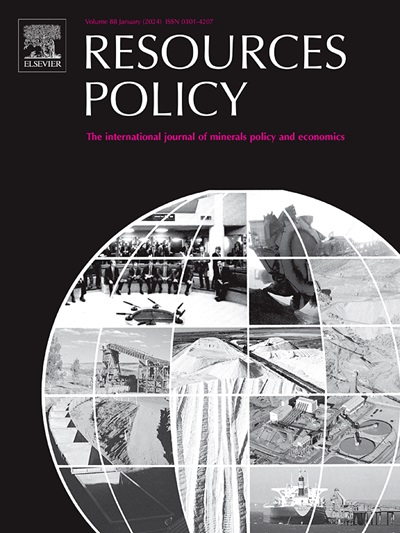埃德蒙顿,一个资源型城市:通过未被认可的资源遗产考察城市发展
IF 10.2
2区 经济学
0 ENVIRONMENTAL STUDIES
引用次数: 0
摘要
艾伯塔省的埃德蒙顿目前与石油和天然气工业有关,但它作为一个资源社区的历史在很多方面不仅不为人知,而且很有影响力,甚至是理解其城市发展的关键。木材采伐,制砖但最重要的是当地的煤矿开采为埃德蒙顿的发展提供了动力和结构。几个社区是这个基础的关键,最终成为许多其他城市维持功能的东道主。Riverdale和Cloverdale这样的河畔社区很容易受到洪水的影响。贝弗利,一个官方的煤矿城镇,有着漫长的斗争历史。麦考利是联邦监狱的所在地;囚犯们在Riverdale地下开采煤炭。埃德蒙顿的煤矿被非正式的社会住房、废物管理、主要的交通项目所取代,最后发展了埃德蒙顿的河谷公园系统。埃德蒙顿提供了一个扩展资源社区叙事的案例研究。埃德蒙顿早期的主要社区展示了煤炭开采如何影响景观、经济转变和城市发展中的关系。GIS分析、当地媒体分析和文献综述相结合的过程为理解埃德蒙顿这个北方大城市最初如何分享小型资源社区早年成长和发展的经验和困难提供了一个框架。可以通过资源遗产的视角来分析那些似乎超越了其采掘起源的大型和多样化的城市,就像在埃德蒙顿一样,它可以揭示,在很大程度上被遗忘的资源消失的历史可以以深刻的方式标志着城市及其规划。因此,我们说的是不透明的资源城市。本文章由计算机程序翻译,如有差异,请以英文原文为准。

Edmonton, a resource city: urban development examined through unrecognized resource legacies
Edmonton, Alberta, is currently associated with oil and gas industries, yet its history as a resource community is in many ways not only obscure but also influential, even key to the understanding of its urban development. Timber harvesting, brick making but most importantly local coal mining powered and structured Edmonton's growth. Several communities were key to this foundation, ultimately becoming hosts for many other city sustaining functions. River flats communities like Riverdale and Cloverdale were vulnerable to floods. Beverly, an official coal mining town had a prolonged history of struggle. McCauley was home to the Federal prison; resident prisoners mined the coal beneath Riverdale. Coal mining in Edmonton was replaced by informal and social housing, waste management, major transportation projects, and finally development of Edmonton's River Valley parks system. Edmonton provides a case study for expanding the resource communities narrative. Key communities in Edmonton's early years show how coal mining influenced landscape, economic shifts, and relationships within a growing city. A combined process of GIS analysis, local media analysis, and literature review provides a framework for understanding how Edmonton, a large northern city initially shared the experiences and difficulties of small resource communities in earlier years of growth and development. Large and diverse cities which seemingly transcended their extractive origin can be analyzed through the lens of resource legacies, which can reveal, as in Edmonton, that largely forgotten histories of vanished resources can mark cities and their planning in profound ways. We therefore speak of opaque resource cities.
求助全文
通过发布文献求助,成功后即可免费获取论文全文。
去求助
来源期刊

Resources Policy
ENVIRONMENTAL STUDIES-
CiteScore
13.40
自引率
23.50%
发文量
602
审稿时长
69 days
期刊介绍:
Resources Policy is an international journal focused on the economics and policy aspects of mineral and fossil fuel extraction, production, and utilization. It targets individuals in academia, government, and industry. The journal seeks original research submissions analyzing public policy, economics, social science, geography, and finance in the fields of mining, non-fuel minerals, energy minerals, fossil fuels, and metals. Mineral economics topics covered include mineral market analysis, price analysis, project evaluation, mining and sustainable development, mineral resource rents, resource curse, mineral wealth and corruption, mineral taxation and regulation, strategic minerals and their supply, and the impact of mineral development on local communities and indigenous populations. The journal specifically excludes papers with agriculture, forestry, or fisheries as their primary focus.
 求助内容:
求助内容: 应助结果提醒方式:
应助结果提醒方式:


